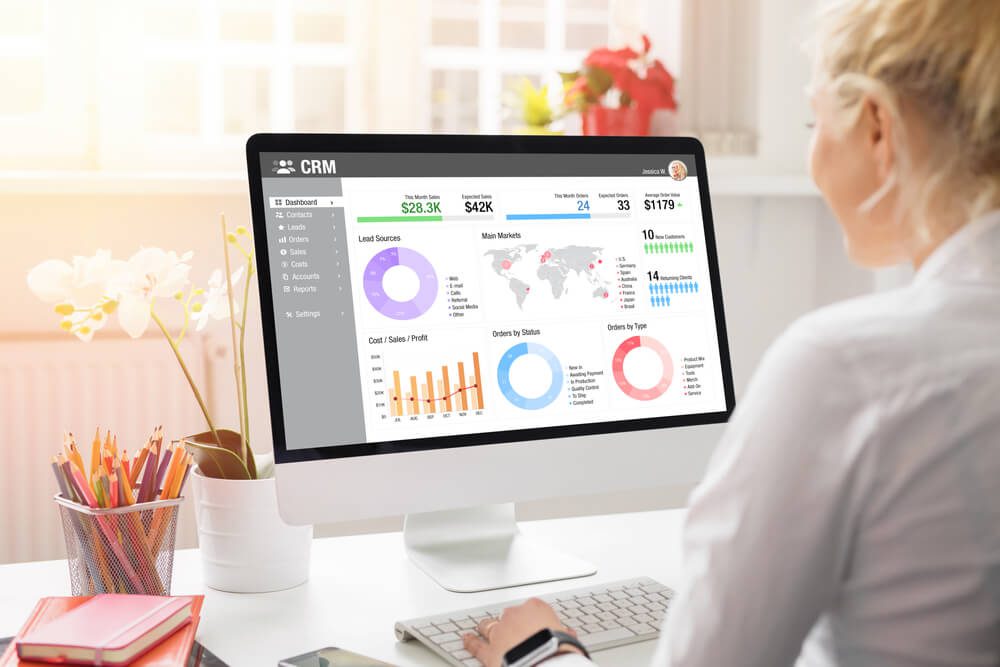
7 Metrics That Matter for Great Sales Pipeline Management
Tracking specific metrics is crucial for evaluating the effectiveness of the sales process. They offer valuable insights into various aspects of the pipeline. These include lead generation, conversion, and deal velocity.
This article explores seven critical metrics in sales pipeline management:
- Lead conversion rate.
- Sales cycle length.
- Average deal size.
- Win-loss ratio.
- Pipeline value.
- Opportunity-to-customer conversion rate.
- Customer acquisition cost (CAC).
This article also discusses how expert fractional sales management services help improve the sales process.
Read below to learn how to identify areas for improvement, optimize sales strategies, and obtain desired outcomes. Let’s go!
Need some direction for increasing sales? Watch this video to learn what DAP can do for you!
1. Lead Conversion Rate
The lead conversion rate is vital when analyzing markets for small- and medium-sized businesses. It provides insights into how well a company turns leads into customers. A high lead conversion rate indicates that the sales team is successfully closing deals and generating revenue from the prospects.
This metric helps businesses understand lead quality by revealing the most lucrative sources or channels. Lead conversion rate also improves sales by pinpointing areas where they might drop off or encounter obstacles.
The following are strategies to effectively measure and improve lead conversion rates:
- Establish clear criteria for a qualified lead based on demographics, behavior, and buyer persona.
- Use customer relationship management (CRM) software or lead tracking systems to monitor the entire lead lifecycle from initial contact to conversion.
- Break down the lead conversion process into stages (e.g., lead capture, qualification, proposal, and closing) and monitor conversion rates at each stage.
- Experiment with lead nurturing strategies such as email campaigns, personalized follow-ups, or targeted content offers.
Continuously analyze lead conversion data to identify trends, patterns, and areas for improvement. Regularly review and iterate on sales processes, messaging, and targeting strategies based on insights gathered from conversion rate analysis.
2. Sales Cycle Length

Tracking the sales cycle length aids marketers in understanding the sales process’s efficiency and optimizing business operations. It measures the time it takes leads to progress through the sales funnel, from initial contact to purchase or a closed deal.
Analyzing sales cycle length allows businesses to identify bottlenecks, streamline workflows, and implement strategies to accelerate the pace of conversions, improving overall sales performance and driving revenue growth.
Besides these sales pipeline management best practices, measure the length of the sales cycle with these tactics:
- Define the stages of the sales cycle to properly track the progression of leads.
- Establish standard time frames for each sales cycle stage based on historical data and industry benchmarks.
- Monitor the movement of leads between different sales cycle stages and record the time spent in each stage.
- Analyze the sales cycle length for customer segments, products, or channels.
Regularly review sales cycle length metrics and identify trends or patterns over time. Use this data to make informed decisions and implement adjustments to streamline processes, improve efficiency, and reduce the sales cycle length.
3. Average Deal Size
Monitoring the average deal size is crucial for accurately forecasting revenue and developing a results-driven sales pipeline. It determines the performance of sales efforts.
Analyzing the average deal size helps with understanding the typical value of sales transactions and more effectively forecasting incoming revenue streams. This allows sales teams to adjust their strategies and resources as needed. They might need to focus on closing more significant deals or increasing the volume of smaller transactions to meet revenue goals.
The following are effective strategies to increase average deal size and sales performance:
- Encourage sales representatives to upsell or cross-sell complementary products or services to existing customers.
- Create packages or solutions that combine multiple products or services at a discounted price.
- Shift the focus of sales conversations from features to value propositions tailored to the customer’s specific needs and pain points.
- Identify and prioritize high-value accounts or segments with the potential for larger transactions.
- Invest time and resources in building relationships with key decision-makers and influencers within these accounts to increase the likelihood of securing larger deals.
- Provide options for customization or additional features that allow customers to tailor their purchases to fit their unique requirements.
Increasing the average deal size boosts individual transaction values and contributes to overall sales performance by driving higher revenue and profitability.
4. Win-Loss Ratio

The win-loss ratio measures sales success and market competitiveness, reflecting the effectiveness in converting opportunities into closed deals. It reveals the strengths and weaknesses of your sales tactics.
Examining the reasons behind wins and losses identifies patterns and trends that refine your sales pipeline, address objections, and adapt strategies to better meet customer needs.
Here are methods to effectively measure the win-loss ratio:
- Use a CRM system to track and record sales opportunities, including won and lost deals. These platforms centralize the storage of relevant data for easy retrieval and analysis.
- Establish clear criteria for categorizing and documenting wins and losses based on deal size, competition, pricing, and customer feedback.
- Engage with customers and prospects who want to understand the factors influencing their buying choices.
- Monitor and track competition to know how your products and services compare with others and why customers prefer another over yours.
- Benchmark the win-loss ratio against industry standards and competitors to gauge your performance.
Finally, regularly analyze win-loss reports to identify the common factors among successful and unsuccessful deals. A fractional sales management agency helps companies look for patterns in customer objections, competitor tactics, and market dynamics to inform strategic decision-making and refine sales strategies.
5. Pipeline Value
The total value of opportunities in the pipeline is a crucial indicator of potential sales growth. This metric estimates revenue based on the probability of closing deals within a specific time frame. In addition, the pipeline value more efficiently allocates resources.
Consider these top strategies to effectively measure the total value of opportunities from managing the pipeline:
- Use a robust CRM platform that tracks and manages all opportunities within the sales pipeline.
- Assign monetary values to each opportunity based on factors such as deal size, projected revenue, and probability of closing.
- Establish clear criteria for estimating the value of opportunities at different stages of the pipeline for consistency and accuracy.
- Monitor the progression of opportunities through different stages of the sales pipeline to assess their likelihood of closing and adjust their monetary values as appropriate.
- Segment the sales pipeline by time frame (e.g., monthly, quarterly, or annually) to analyze the value of opportunities expected to close within specific periods.
- Conduct regular sales pipeline reviews to update opportunity values, reassess probabilities, and remove outdated or irrelevant opportunities.
- Compare the total pipeline value to historical data and benchmarks to assess growth trends and performance improvements.
With these strategies, businesses can effectively measure the total value of opportunities in their sales pipeline, gain insights into revenue projections, and make data-driven decisions for sustainable growth and success.
6. Opportunity-to-Customer Conversion Rate

Tracking the conversion rate of opportunities to actual customers evaluates the effectiveness of the final stages of the sales process. This metric provides insights into the efficiency of converting leads into paying customers and highlights the performance of sales efforts in closing deals.
Fractional sales managers use this metric when making sales projections. It identifies bottlenecks, optimizes sales strategies, and more effectively allocates resources.
The following helps measure the opportunity-to-customer conversion rate:
- Define the criteria that determine when an opportunity transitions into a customer. Establish specific milestones or actions that signify successful conversion, such as signing a contract, purchasing, or completing an agreement.
- Use CRM software that tracks and manages the entire sales process, from lead generation to customer conversion.
- Segment conversion rates based on different factors such as sales team, product or service offerings, geographical regions, or customer segments.
- Monitor the time it takes for opportunities to convert into customers. Analyzing conversion time frames helps identify inefficiencies or delays in the sales process.
- Gather feedback from customers who have completed the conversion process to understand their experience, satisfaction levels, and reasons for choosing your company.
- Benchmark the opportunity-to-customer conversion rate against industry standards and competitors to assess the company’s performance and competitiveness.
7. Customer Acquisition Cost (CAC)
CAC is one of the key performance indicators for sales. It represents the investment required to acquire a new customer. Fractional sales managers often compare it with the customer lifetime value (LTV) to determine the profitability of acquisition efforts. It also helps marketers decide on resource allocation, pricing strategies, and customer retention initiatives.
Calculate CAC with this formula: CAC = total sales and marketing expenses / number of new customers acquired.
Improve your CAC with these techniques:
- Keep detailed records of all marketing and sales expenses incurred over a specific period. These include advertising costs, sales team salaries, software subscriptions, and promotional expenses.
- Analyze the CAC of marketing channels such as social media advertising, content marketing, email campaigns, and paid search.
- Consider overhead costs associated with customer acquisition such as administrative expenses, infrastructure costs, and technology investments.
- Determine the CAC payback period by dividing the CAC by the average revenue generated per customer per month.
Regularly monitor and analyze CAC to identify fluctuations, seasonality, and market changes influencing it. Work with an experienced fractional sales management services agency for efficient CAC monitoring and optimization.
Summing Up
Monitoring these seven metrics is crucial for effective sales performance and strategic decision-making. They provide valuable insights into various aspects of the sales process. These include lead generation, conversion rates, revenue, and customer acquisition costs.
Regularly monitoring these metrics also helps sales managers identify trends, pinpoint areas for improvement, and make data-driven decisions to optimize the sales pipeline and drive business growth.
How can your sales teams leverage technology to track these metrics more efficiently and accurately? Contact Digital Authority Partners (DAP) today and schedule a free consultation with a fractional sales management services expert.
Want To Meet Our Expert Team?
Book a meeting directly here




